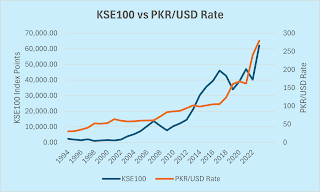Over the past few months, the banking sector has seen significant buying momentum. Of course, the banking sector is not alone in this as the pharmaceutical, fertilizer and oil & gas exploration sectors have also seen a notable re-rating. However, what makes the banking sector special is that it possesses the highest weight in the KSE100 index – comprising 25.85% of the index. Moreover, there are 15 banks included in the KSE100 index making it the most represented sector in the index.
As a result, it should come as no surprise that the index is up over 16% since the start of November and up nearly 35% since the start of September. Over that same time frame, the BKTI (an index representative of the banking sector) is up over 16% and 31%, respectively.
Of all the banks listed in the KSE100
index, only three banks have not been a party to this rally – Meezan Bank
(MEBL), Faysal Bank (FABL) and Standard Chartered (SCBPL). FABL is down 5%
since the start of September and November, while MEBL is down 1% and up 1% (respectively)
over the same time frame. Their underperformance is understandable given that
the SBP imposed a minimum deposit rate on Islamic deposits last
month.
It can also be said that SCBPL missed a Q3
dividend but so what? Many companies have missed a dividend, and the market
bats an eye for a while but then sees value and bids the share price up. A key
example would be Airlink which skipped a dividend for Q3, but its share price
has continued its ride upwards.
On a relative basis, SCBPL would be most comparable to MCB and UBL given the similar risk profile (low risk), growth rates, high dividend yield and high payout ratio of the three banks.
Based upon this, it could be argued that
UBL is expensive, however UBL has rallied very much in line with the broader
banking sector and market. If anything, MCB and SCBPL would appear to be
undervalued. Given SCBPL’s higher yield and its lacklustre price performance
since September, it would make for a stronger investment case.
Naturally, when one finds such a case of
undervaluation, you have to wonder: how did the share get to this place? And
then one wonders: what will be the trigger to cause value realization? To
answer the former question, SCBPL is relatively small bank in terms of deposits
and assets, so it goes under the radar. In fact, it has a beta of 0.55
highlighting it tends to not be heavily correlated with the index and the need
for triggers to realize value.
As for the latter question, the upcoming
Q4 earnings season could be the important trigger which causes a re-rating of
SCBPL especially since it skipped a dividend for Q3. Expectations of a higher
year-end dividend could drive up SCBPL’s share price. Plus, the market might
take notice anyways since the banking sector has received key attention. So
much so that even smaller banks like Soneri Bank have rode the wave of optimism
recently.
Furthermore, there have been rumours that SCBPL’s
downsizing of traditional banking network (bank branches) is indicative that it
is preparing for a delisting or exit from Pakistan. If these rumours re-appear,
they could act as a strong trigger for value realization.
Finally, a key concern that investors have
when analyzing SCBPL is that it trades at a relatively high price-to-book
ratio. Yet, this is a non-concern because a high price-to-book ratio is a
function of a higher ROE. This blog has discussed this linear relationship
between P/B ratio and ROE previously.
Consequently, SCBPL’s relatively high P/B ratio is well-justified.
A high-quality bank such as SCBPL probably shouldn’t trade this way (sideways). At least, historically it hasn’t for too long.


























